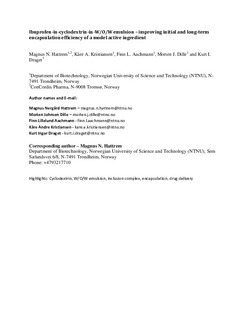| dc.contributor.author | Hattrem, Magnus | |
| dc.contributor.author | Kristiansen, Kåre Andre | |
| dc.contributor.author | Aachmann, Finn Lillelund | |
| dc.contributor.author | Dille, Morten Johnsen | |
| dc.contributor.author | Draget, Kurt Ingar | |
| dc.date.accessioned | 2017-11-06T10:46:53Z | |
| dc.date.available | 2017-11-06T10:46:53Z | |
| dc.date.created | 2015-06-04T12:40:01Z | |
| dc.date.issued | 2015 | |
| dc.identifier.citation | Internation Journal of Pharmaceutics. 2015, 487 (1-2), 1-7. | nb_NO |
| dc.identifier.issn | 0378-5173 | |
| dc.identifier.uri | http://hdl.handle.net/11250/2464184 | |
| dc.description.abstract | A challenge in formulating water-in-oil-in-water (W/O/W) emulsions is the uncontrolled release of the encapsulated compound prior to application. Pharmaceuticals and nutraceuticals usually have amphipathic nature, which may contribute to leakage of the active ingredient. In the present study, cyclodextrins (CyDs) were used to impart a change in the relative polarity and size of a model compound (ibuprofen) by the formation of inclusion complexes. Various inclusion complexes (2-hydroxypropyl (HP)-β-CyD-, α-CyD- and γ-CyD-ibuprofen) were prepared and presented within W/O/W emulsions, and the initial and long-term encapsulation efficiency was investigated. HP-β-CyD-ibuprofen provided the highest encapsulation of ibuprofen in comparison to a W/O/W emulsion with unassociated ibuprofen confined within the inner water phase, with a four-fold increase in the encapsulation efficiency. An improved, although lower, encapsulation efficiency was obtained for the inclusion complex γ-CyD-ibuprofen in comparison to HP-β-CyD-ibuprofen, whereas α-CyD-ibuprofen had a similar encapsulation efficiency to that of unassociated ibuprofen. The lower encapsulation efficiency of ibuprofen in combination with α-CyD and γ-CyD was attributed to a lower association constant for the γ-CyD-ibuprofen inclusion complex and the ability of α-CyD to form inclusion complexes with fatty acids. For the W/O/W emulsion prepared with HP-β-CyD-ibuprofen, the highest encapsulation of ibuprofen was obtained at hyper- and iso-osmotic conditions and by using an excess molar ratio of CyD to ibuprofen. In the last part of the study, it was suggested that the chemical modification of the HP-β-CyD molecule did not influence the encapsulation of ibuprofen, as a similar encapsulation efficiency was obtained for an inclusion complex prepared with mono-1-glucose-β-CyD. | nb_NO |
| dc.language.iso | eng | nb_NO |
| dc.publisher | Elsevier | nb_NO |
| dc.rights | Attribution-NonCommercial-NoDerivatives 4.0 Internasjonal | * |
| dc.rights.uri | http://creativecommons.org/licenses/by-nc-nd/4.0/deed.no | * |
| dc.title | Ibuprofen-in-cyclodextrin-in-W/O/W emulsion - Improving the initial and long-term encapsulation efficiency of a model active ingredient. | nb_NO |
| dc.type | Journal article | nb_NO |
| dc.type | Peer reviewed | nb_NO |
| dc.description.version | acceptedVersion | nb_NO |
| dc.source.pagenumber | 1-7 | nb_NO |
| dc.source.volume | 487 | nb_NO |
| dc.source.journal | Internation Journal of Pharmaceutics | nb_NO |
| dc.source.issue | 1-2 | nb_NO |
| dc.identifier.doi | 10.1016/j.ijpharm.2015.03.059 | |
| dc.identifier.cristin | 1246305 | |
| dc.relation.project | Norges forskningsråd: 221576 | nb_NO |
| dc.description.localcode | © 2015. This is the authors’ accepted and refereed manuscript to the article. This manuscript version is made available under the CC-BY-NC-ND 4.0 license http://creativecommons.org/licenses/by-nc-nd/4.0/ | nb_NO |
| cristin.unitcode | 194,66,15,0 | |
| cristin.unitname | Institutt for bioteknologi og matvitenskap | |
| cristin.ispublished | true | |
| cristin.fulltext | postprint | |
| cristin.qualitycode | 1 | |

